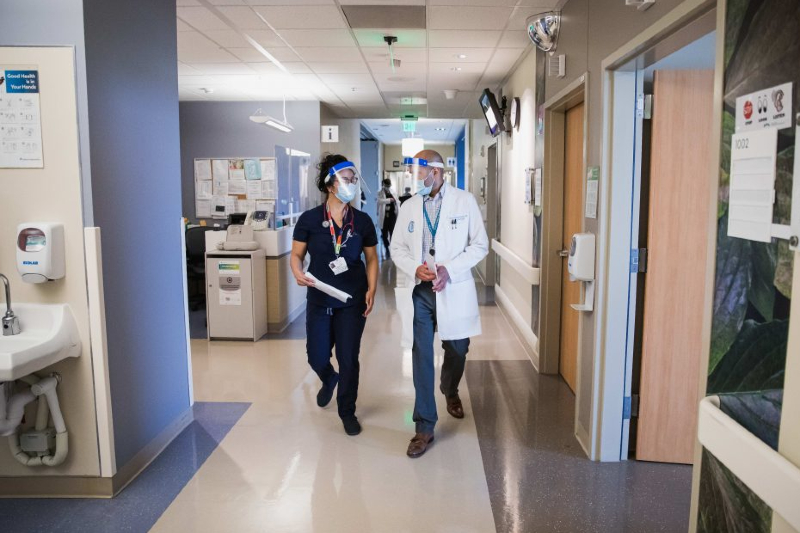PermanenteDocs Chat podcast on flu, COVID, and RSV vaccine safety and effectiveness updates with Sandra Fryhofer, MD, of the American Medical Association.

Reducing racial disparities in health care delivery
As the pandemic surges and the nation prepares for a new administration, it has never been more important to acknowledge and address racial disparities that are being exacerbated by COVID-19.

In this interview, Nancy Gin, MD, FACP, executive vice president of quality and chief quality officer for The Permanente Federation, discusses the current health disparities that are playing out, lifts up Kaiser Permanente’s response to racial health disparities during COVID-19, and offers policy solutions that could make a difference now.
How are racial disparities playing out in the COVID-19 epidemic?
As with other disparities in health care, COVID-19 is disproportionately affecting communities of color. New data shows that Black and Latinx patients of all ages in the United States have been 3 times as likely to contract COVID-19 and are being hospitalized at more than 4.5 times the rate of white people. These communities are also nearly twice as likely to die from the virus compared to their white counterparts.
There are several reasons for this, including access to health care, proper nutrition, higher rates of preexisting conditions, and other socioeconomic and environmental factors. Preexisting conditions — such as hypertension, diabetes, and respiratory diseases such as chronic obstructive pulmonary disease (COPD) and asthma — predispose people to have a more significant course of COVID-19. In addition, people of color are disproportionately represented in roles identified as “essential,” increasing their risk of exposure within service industries.
Factors such as systemic racism also cause and exacerbate health disparities. The legacy of redlining, for example, has pushed Black residents into poor, densely populated communities with higher levels of pollution and environmental hazards and with more limited access to resources, including health care.
What are you hearing from physicians on the front-line of the pandemic about what patients of color are most concerned about right now?
Like most patients, they’re concerned about accessing the care they need in a safe manner. So at Kaiser Permanente, we have taken measures to provide as many opportunities for “touchless” interactions. That is one reason why we’ve ramped up our telehealth program to provide more care virtually.
But there is a digital divide that we need to recognize. Many people in traditionally underrepresented communities may not have access to a smartphone or tablet, or have sufficient broadband for a reliable connection. Some also can’t afford the cost of high-speed internet. Other groups may have access to the technology but lack the digital literacy necessary to use some telehealth options.
Some telehealth programs, which can include remote monitoring via an app or logging into a secure account on a health care website, require knowing how to do basic things like downloading an app, making sure your device is updated with the latest programs, or even knowing where to click. We know that the adoption and overall use of telehealth increase when health technology is tailored to user needs. Digital literacy and access to the technology among certain underserved members of our communities.
How is Kaiser Permanente responding to current disparities in care and outcomes?
Kaiser Permanente has always had a deep and abiding commitment to health equity long before the pandemic began. We have focused for years on eliminating health disparities among certain ethnic groups, including efforts to reduce hypertension rates among Black patients and increasing colon cancer screening in the Latinx community.
With this foundation of providing innovative ways to reach different ethnic communities, we are ideally positioned to reduce health disparities prior to, during, and after the COVID-19 pandemic.
Some of the changes we’ve implemented during COVID-19 to address health disparities include:
- Increasing awareness of and education about COVID-19 stigma, disparities, and mitigation strategies for our physicians, staff, and employees, including distribution of a “COVID-19 Reducing Stigma Toolkit.”
- Expanding testing criteria to include high-risk groups.
- Implementing workflow changes that enhance member engagement around COVID-19 prevention, testing, and treatment in a culturally responsive manner.
- Expanding our community health partnerships to help address social determinants of health and advocate for our most vulnerable members and their families.
- Providing interpreter services for our virtual visits as needed.
What public policy changes do you think would be most helpful in reducing disparities in care right now?
To better understand the health disparities with COVID-19, it’s important to have robust data. The U.S. Department of Health and Human Services (HHS) recently released guidance that requires labs to include race and ethnicity, along with age, sex, and ZIP code, when reporting COVID-19 test results. This information will be instrumental in understanding which communities are hit hardest by the virus; where to allocate resources such as medical staff, tests, and personal protective equipment; and, how to plan for and further reduce disparities in the future.
However, this data wasn’t required before August 1, which means we are missing this information from the millions of cases in the United States since the start of the pandemic. In order to get a better picture of how COVID-19, or any disease, affects the community at large, it’s best to collect these details from the start. But the pandemic will be with us for a while, and having the data moving forward will still help our understanding of how best to focus our efforts in reducing disparities.
The Affordable Care Act included a non-discrimination requirement that health organizations must make non-English language assistance available to patients, which Kaiser Permanente has done for years. Even though that requirement has since been eliminated, we remain committed to all of our members and patients, regardless of their backgrounds, and continue to provide non-English printed and online materials. Language interpreters are also available during clinic visits to support clinician-patient conversations and decision-making.
These are just a few examples of interventions we will need to end inequities. Events like the COVID-19 pandemic have made it clear that long-term investments in underrepresented communities are needed to level the playing field when it comes to health and health care.
This is reprinted from the Kaiser Permanente Institute for Health Policy blog.

